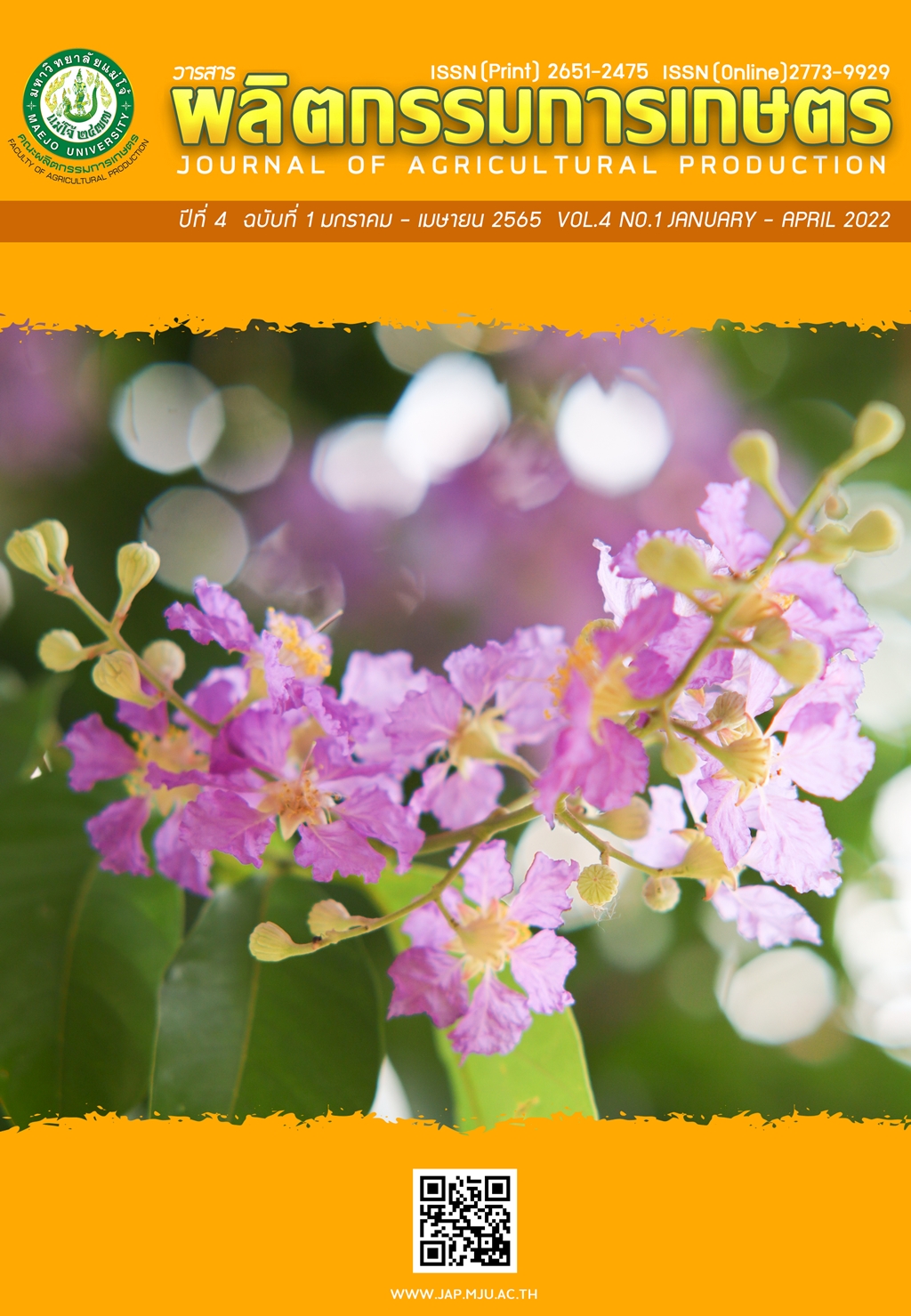การเจริญเติบโตและพัฒนาของข้าวก่ำบางพระที่ปลูกภายใต้สภาพแสงที่แตกต่างกัน
Main Article Content
บทคัดย่อ
การทดลองนี้เป็นการศึกษาการเจริญเติบโตและพัฒนาการของข้าวก่ำบางพระที่ปลูกภายใต้แสงที่ แตกต่างกัน โดยวางแผนการทดลองแบบ Completely Randomized Design มีจํานวน 5 สิ่งทดลอง คือ สิ่งทดลองที่ 1 แสงธรรมชาติ (T1) มีค่าเท่ากับ 620 ไมโครโมล/วินาที/ตารางเมตร สิ่งทดลองที่ 2 LED white: red: blue bulb panel (T2) สิ่งทดลองที่ 3 LED white HP4F-AL (T3) สิ่งทดลองที่ 4 LED full spectrum grow board (T4) และ สิ่งทดลองที่ 5 fluorescent (T5) ดําเนินการทดลองตั้งแต่เดือน สิงหาคมถึงธันวาคม 2563 ณ สาขาวิชาเทคโนโลยีการผลิตพืช คณะเกษตรศาสตร์และทรัพยากรธรรมชาติ มหาวิทยาลัยเทคโนโลยีราชมงคลตะวันออก ผลการทดลองพบว่าข้าวก่ำบางพระมีการเจริญเติบโตในด้าน ความสูงมากที่สุดใน T3 (156.4 เซนติเมตร) มีจํานวนหน่อต่อกอมากใน T1 (11.9 ต้นต่อกอ) นํ้าหนักสด และฟางมากที่สุดใน T1 (252.7 และ 74.0 กรัม) และจํานวนเมล็ดดีมากที่สูงสุดใน T3 (353.2 เมล็ดต่อ รวง) สําหรับระยะพัฒนาการของข้าวกํ่าบางพระพบว่า ข้าวที่ปลูกใน T2 มีระยะพัฒนาการเร็วที่สุดคือ ระยะตั้งท้อง 60 วัน ระยะออกดอก 95 วัน และระยะเก็บเกี่ยว 130 วัน ส่วนข้าวที่ปลูกใน T5 มีระยะพัฒนาการด้านต่าง ๆ นานที่สุด ในการวิเคราะห์ปริมาณอะไมโลส พบว่า มีปริมาณอะไมโลสอยู่ระหว่าง 18.02-19.32 % อยู่ในเกณฑ์ระดับตํ่า และ T4 มีปริมาณอะไมโลสมากที่สุดเท่ากับ 19.32 % ดังนั้นจากผลการทดลองการใช้แสงเทียมสามารถปลูกพืชในพื้นที่ที่มีแสงน้อยได้
Article Details

อนุญาตภายใต้เงื่อนไข Creative Commons Attribution-NonCommercial-NoDerivatives 4.0 International License.
เอกสารอ้างอิง
กรมการข้าว. 2549. องค์ความรู้เรื่องข้าว. กระทรวงเกษตรและสหกรณ์, กรุงเทพฯ.
ศานิต สวัสดิกาญจน์. 2549. การเจริญเติบโตของข้าวในสภาวะที่มีความเข้มแสงต่างกัน. คณะวิทยาศาสตร์และเทคโนโลยี มหาวิทยาลัยราชภัฏพระนครศรีอยุธยา. พระนครศรีอยุธยา.
สถาบันวิจัยข้าว. 2544. ความรู้เรื่องข้าว. ฝ่ายถ่ายทอดเทคโนโลยี สถาบันวิจัยข้าว กรมวิชาการเกษตร. กระทรวงเกษตรและสหกรณ์, กรุงเทพฯ.
อรอนงค์ นัยวิกุล. 2550. ข้าว: วิทยาศาสตร์และเทคโนโลยี. (พิมพ์ครั้งที่ 2). กรุงเทพฯ: มหาวิทยาลัยเกษตรศาสตร์. 366 หน้า.
Coffman, W. R. and B. O. Juliano. 1987. Rice. In R. A. Olson, & K. J. Frey. (Eds). Nutritional quality of cereal grains: Genetic and agronomic improvement (vol. 5) (pp.101-131). Madison: American Society of Agronomy.
De Salvador, F.R., G. Scarascia Mugnozza, G. Vox, E. Schettini, M. Mastrorilli, and M. Bou Jaoudé. 2008. Innovative photoselective and photoluminescent plastic films for protected cultivation. Acta Hortic. 801(PART 1): 115-121.
Drozdova, I.S., V.V. Bondar, N.G. Bukhov, A.A. Kotov, L.M. Kotova, S. N. Maevskaya and A.T. Mokronosov. 2001. Effects of light spectral quality on morphogenesis and source-sink relations in radish plants. Russ. J. Plant Physiol. 48: 415-420.
Gautier, H., C. Varlet-Grancher, and L. Hazard. 1999. Tillering responses to the light environment and to defoliation in populations of perennial ryegrass (Lolium perenne L.) selected for contrasting leaf length. Ann. Bot. 83: 423-429.
Juliano, B.O., B. Ricardo and G.E. Luiz. 1971. Evaluation of the protein quality and milled rices differing in protein content. J. Agric. Food Chem. 19(5): 1028-1034.
Keiko O.K., M. Ryo, G. Eiji, F. Kazuhiro and K, Kenji. 2006. Growth of rice plants under red light with or without supplemental blue light. Soil Science and Plant Nutrition 52: 444-452.
Kobata, T. and N. Moriwaki. 1990. Grain growth rate as a function of dry matter production rate: An experiment with two rice cultivars under different radiation environments. Jpn. J. Crop Sci. 59: 1-7.
Kobata, T., M. Sugawara and S. Takatu. 2000. Shading during the early grain filling period does not affect potential grain dry mater increase in rice. Agron. J. 92: 411-417.
Li, Q. and C. Kubota. 2009. Effects of supplemental light quality on growth and phytochemicals of baby leaf lettuce. Environ. Exp. Bot. 67: 59-64.
Monostori, I., H. Márk, K. Gábor, R. Marianna, A. Mohamed, B.A. Susan, S. Gabriella, P. Magda, T. Dávid, S.S. Livia, H. Noémi, G. Gábor, and D. Éva. 2018. LED Lighting – Modification of Growth, Metabolism, Yield and Flour Composition in Wheat by Spectral Quality and Intensity. Frontiers in Plant Science. 9 Article 605.
Promsomboon, P., and S. Promsomboon. 2016. Collection and Evaluation of Local Thai Rice Varieties (Oryza sativa L.). Journal of Life Sciences 10: 371-374.
Promsomboon, P., and S. Promsomboon. 2019. Environmental responsibility of rice var. Kum Bangpra and riceberry in lowland and upland conditions. International Journal of Agricultural Technology 15: 747-752.
Rahman, M.T. and M.T. Islam. 2002. Effect of water stress at different growth stages on yield and yield contributing characters of transplanted aman rice. Pak. J. Biol. Sci. 5: 169-172.
Smith, H. and G.C. Whitelam. 1997. The shade avoidance syndrome: multiple responses mediated by multiple phytochromes. Plant Cell Environ. 20: 840-844.
Tran, L.H. and S. Jung. 2017. Effects of LightEmitting Diode Irradiation on Growth Characteristics and Regulation of Porphyrin Biosynthesis in Rice Seedlings. Int. J. Mol. Sci. 18: 641. 1-11.
Wopereis, M.C.S., M.J. Kropff, A.R Maligaya and T.P. Tuong. 1996. Drought-stress responses of two lowland rice cultivars to soil water status. Field Crop Res. 46: 21-39.
Yorio, N.C., G.D. Goins, H.R. Kagie, R.M. Wheeler and J.C. Sager. 2001. Improving spinach, radish, and lettuce growth under red light-emitting diodes (LEDs) with blue light supplementation. Hort. Sci. 36: 380-383.


